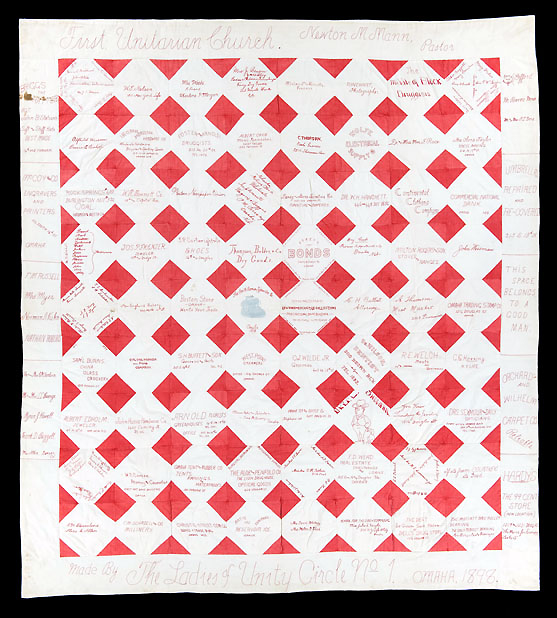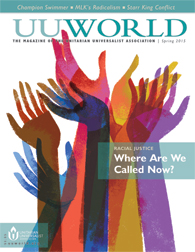
Historic quilt becomes time capsule for Nebraska congregation
Omaha UUs restore and celebrate 1898 ‘signature quilt’
Included were names of more than 70 businesses and individuals, including a creamery, a dressmaker, a manufacturer of wagons and buggies, two ice companies, and a "school for the cure of stammering." There’s also an "S.H. Buffett and Son, Groceries and Fruits" block, harking back to one of Omaha’s more famous families.
When the "Redwork signature quilt" with "turkey red" squares on white muslin was completed, it was celebrated and no doubt displayed for a while, and then it was put away in storage. It was brought out for special occasions over the years, according to church lore. But then at some point it became lost, and it remained lost for many years.
And then last fall it was found, tucked into a bag in the church archives. When it was discovered, only the top remained. The bulky backing had been removed in some long- ago effort to preserve the antique quilt.
It was Yvonne Price’s curiosity that led to the rediscovery. A member of the congregation for about 40 years, she was thinking about organizing a quiltmaking project as a church fundraiser. Then she remembered a church program from decades earlier about the 1898 quilt, presented by a man whose name she couldn’t remember. "We even had a photo of him holding the quilt," Price said. "I was so impressed with all those names on the quilt that I went looking for it."
After some searching from attic to basement, the quilt turned up in a bag at the bottom of a storage box. "I opened the bag and it just brought me to tears because of what it represented to us," Price said.
The quilt provides a tangible connection not only with an earlier generation of members, but also it reinforces the congregation’s connections with the larger community. Prominent at the top of the quilt is the name of the Rev. Newton M. Mann, the congregation’s minister at the time. Price has not been able to determine how much money the quilt brought in for the church in 1898. She does know from church records that at about that same time the church was in arrears to Rev. Mann to the tune of about $400.
The congregation paid $1,600 to have a conservator restore the quilt, including putting a new backing on it. On Saturday, December 7, the congregation will hold an open house, inviting Omahans to come see the quilt. The next day the worship service will focus on the quilt, said Price. Then, in a ceremony at coffee hour, the quilt will be handed over to Carolyn Ducey, curator of collections at the International Quilt Study Center & Museum at the University of Nebraska-Lincoln.
"The museum is happy to have it," said Price. "And the quilt will be preserved there for a long time to come." She said the museum has agreed to let the congregation borrow the quilt for upcoming commemorative events—the 100th anniversary of the church building in 2018, and the 150th anniversary of the congregation’s founding in 2019.
"I don’t know how many people will come from the community on December 7," she said, "but we want to make it available. We look at this as part of the web of time that connects us with the past as well as the future here in Omaha. And it’s a priceless gift to future generations."
Price said an effort is being made to track down descendants of people whose names are on the quilt. "We’re going to make as big a deal out of this as we can," said Price.
Megan Gustafson, chair of the Religious Services team at First Unitarian, said the service will focus on "how the women of the church used their gifts to help sustain its mission." She and other women plan to present theatrical vignettes from a book, The Quilters: Women and Domestic Art, which is based on oral histories of quilters from around 1900. She added, "We also hope to add some letters, reports, and other firsthand materials from the congregation’s archives to showcase the history of the church and the town at that time. We’ll also add hymns and American folk music from that period."
Congregants also made a video of the quilt, before it was restored. It focuses in on each of the squares, presenting a time capsule of Omaha businesses in 1898.
Photograph (above): Lost for many years, this Redwork signature quilt was recently refurbished by members of the First Unitarian Church of Omaha (© First Unitarian Church of Omaha). See sidebar for links to related resources.
Comments powered by Disqus






